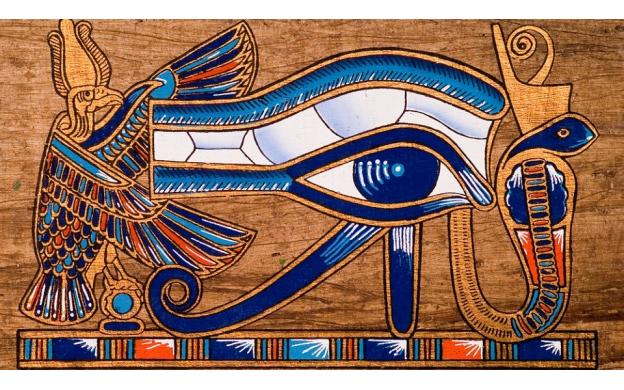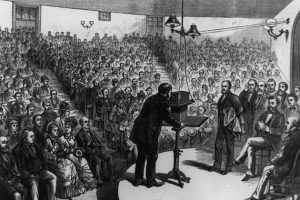Horus, the god of both the daytime sky and of war, is one of the most interesting and confusing of the Egyptian gods. Horus is often depicted as a falcon, or at times as a man with a falcon head–as were many other gods such as Har, Heru, or Hor.1 What is known about him is that he is the son of Osiris and an enemy of Set, the god of the night sky. Horus was, in ancient times, considered to be the perfect god for unifying Upper and Lower Egypt, even before the actual unification took place. This is due to the fact that he was considered the greatest of the gods in both parts of Egypt. The pharaoh was actually considered to be an embodiment of Horus.2
This myth formed the foundations of ancient Egyptian religious faith. This is because when the pharaoh died it was believed that he would become one with Osiris, the father of Horus, ensuring Egyptians eternal life after death. Egyptologist Rosalie David explains, “As the incarnation [flesh-and-blood form] of the god Horus, and the son of Ra and divine heir, only [the pharaoh] could act as mankind’s agent in the presence of the gods. The Egyptians considered the rituals to be effective only if they were enacted by the king to whom the gods had given the rulership. Only he could attend to their needs and execute their orders.”3
Also known as Wadjet, the Eye of Horus is commonly seen as a symbol of protection. The symbol appears in much of the jewelry in the ancient world as it brings about “the safety and health of the bearer and provide wisdom and prosperity.”4 The actual eyes can still be seen today in that they were considered–literally–to be the sun and moon. When Horus was still young, Seth, his uncle and god of the night, tore out his eyes after murdering his father Osiris. This version of the myth is actually quite disturbing as it states that Seth tears out Horus’ left eye, and through an odd set of events loses his man parts! Thoth magically restores the eye after being called upon by Horus’ mother, giving it the name Wadjet, and it is for this reason that the waxing and waning of the moon occurs in cycles and the moon is torn away before its renewal every lunar month.5 On top of that, Thoth resurrected Osiris, granting him eternal life.

In one of the many versions of the myth, the right eye of Horus (representative of the sun) was torn out by Set during battle. Djehuty restored most the eye except for a small piece. This missing part is where the myth of Horus-eye fractions stems from. In this system, parts of the eye were assigned fractional equivalents ranging from 1/2, 1/4, 1/8, 1/16, 1/32, to 1/64.6 When added, these fractions total 63/64, known in mathematical circles as a reciprocal 2n series and a complementary fraction. The Horus-eye of fractions was used for measuring grains and medicines.7
The Wedjat symbol was depicted in a variety of ways in ancient Egypt. Many Egyptians would wear it as an amulet fashioned from gold, silver, granite, hematite, porcelain, or wood.8 It was worn to bring strength, protection, safety, and good health. In a ritualistic sense, the amulet was made as offerings during the summer solstice when the sun was “the most powerful.”9 In fact, the eye still represents a sign that is seen in today’s modern medical vernacular: Rx.10 The Wedjat was printed on papyrus documents containing medical information. The symbol has continued to be used on medical record in Europe, but over time it was replaced by the symbol of Jupiter from Roman mythology, and as even more time passed was changed to the symbol we all know today as Rx.
- Philip’s Encyclopedia, 2007, s.v. “Horus.” ↵
- Philip’s Encyclopedia, 2007, s.v. “Horus.” ↵
- Don Nardo, Egyptian Mythology (Detroit: Lucent Books, 2013), 48. ↵
- Encyclopedia of African Religion, 2009, s.v. “Eye of Horus,” by Denise Martin. ↵
- Encyclopedia of African Religion, 2009, s.v. “Eye of Horus,” by Denise Martin. ↵
- Encyclopedia of African Religion, 2009, s.v. “Eye of Horus,” by Denise Martin. ↵
- Encyclopedia of African Religion, 2009, s.v. “Eye of Horus,” by Denise Martin. ↵
- Encyclopedia of African Religion, 2009, s.v. “Eye of Horus,” by Denise Martin. ↵
- Encyclopedia of African Religion, 2009, s.v. “Eye of Horus,” by Denise Martin. ↵
- Encyclopedia of African Religion, 2009, s.v. “Eye of Horus,” by Denise Martin. ↵



44 comments
Michelle Falcon
This article was very interesting, it consisted of information of the Eye of Horus, also known as the Falcons Eye. According to the article Horus was considered to be the “perfect god”, which is why he was worshiped by all and make made Pharaoh strive to be like him. The Eye of Horus is said to be a symbol of wisdom and strength. Because of this the Eye of Horus was wear for protection, safety, fashion and over all good health. This article was very informational and over all a good read.
Veronica Spryszynski
Amazing to think that Rx comes so far from Egyptian beliefs. How they listed the right eye with fractions is confusing to me but at the same time astonishing that they could come up with such equations for medicine and to measure. I wonder why Horus killed his father Osiris. I liked how there was a battle between all the gods and know I know the meaning of the Egyptian eye.
Oceane Roux
Thank you for this great article! I did not know much about the Egyptian culture, and I have seen the right eye of Horus many times without knowing where it comes from. I enjoyed reading this article, especially the myths about ancient Egyptian Gods. I think that the Egyptians are fascinating for their culture and religion and it is amazing how advanced they were in maths and general sciences for their time.
Aimee Trevino
I always love reading about the Egyptian civilization! I had heard of the eye of Horus, but I really enjoyed your description and explanation of how they used it for protection. I did not know that they were also used for other reasons, like measurement. The Egyptians always had a reason and a use for everything, and you can really see that with the eye of Horus, as they even used it for measuring grains and medicine. Great article!
Aaron Jaramillo
Wow what and amazing article Andrew, it was well written and well researched. Anything dealing with the Egyptians automatically grabs my attention. You did a very nice job describing the Eye of Horus. I had no previous knowledge of the eye so reading your article helped me understand it. Overall, great article and I can’t wait to read more from you!
Alejandro Alcala
What an interesting topic! It is always interesting to learn something new about ancient Egypt. Just like in today’s society, the Egyptians loved their jewelry. I liked though how the jewelry had meaning to it like ones with the Eye of Horus. The story of the Eye of Hours is crazy; whoever came up with the story is very creative. It is also interesting to know the eye had fractions assigned and were used for measuring medicines.
Luke Trevino
Wow great article! This was very well researched and you did a very good job explaining the meaning behind the symbolism! I think it’s amazing how the Egyptians saw his eye as diffeeent meanings ranging from strength all the way to measuring grain and medicine. I liked also how you explained several different stories in this because they are called myths because there is never a set in stone story! Overall very good article!
Johnanthony Hernandez
Interesting article, Egypt has always had many different myths about the gods of the ancient kingdoms. But I didn’t know that the myths surrounding Horus and the Wadjet were so…graphic to say the least. I honestly did know much about the Wadjet or that it had a name, I’ve always referred to it as The Eye of Horus. Nor did I know that both the Northern and Southern Kingdoms had such similar but such different myths regarding how the Wadjet came to be or that he was one of the few gods to remain the same and be so highly revered by both kingdoms and both pharaohs.
Zaraly Frasquillo
I enjoyed reading this article a lot mainly because at first I had no clue who Horus was and what the Wadjet was, but now I do. And I’m really glad you wrote about this. I really liked the way you organized this and how informative your article was. Overall you did a great job writing your article. I can’t wait to read your future articles!
Jennifer Pogue
Great article! Your writing style is very enjoyable and easy to understand. I enjoyed your cover image, it was one of the reasons I clicked on your article. You did a very good job of giving background information on how the Eye of Horus came to be and what it was then used for. I have seen the eye before on jewelry or clothing items, but I never knew it had any historical or medical past.